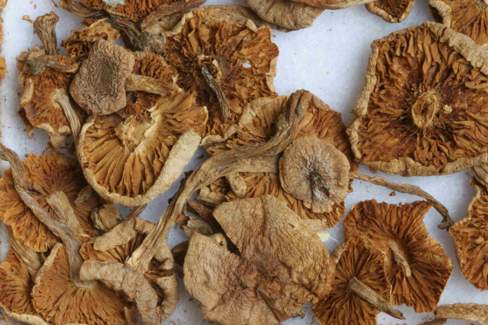 Hebeloma pascuense (Photo: With thanks to New York State Museum)
Hebeloma pascuense (Photo: With thanks to New York State Museum)Taxonomy
Full name: Hebeloma pascuense Peck, Ann. Rep. N.Y. St. Mus. 53: 844 (1901)Genus: Hebeloma
Section: Hebeloma
Subsection: Hebeloma
Types: UNITED STATES: New York: Johnson County, Warrensburg (approx. 43.49°N, 73.77°W, alt. approx. 220 m a.s.l.) on stony soil in pastureland, 18 Oct. 1899, C.H. Peck (Holotype. herbarium acc. no. NYS-F-002278, HJB1000090; Isotype. herbarium acc. no. WTU-F-043852, HJB1000556).
- arrow_drop_downarrow_drop_upEtymologyFrom pascuus (Latin), meaning ‘pastural, relating to pastures’.
- arrow_drop_downarrow_drop_upDiagnosisPileus convex, becoming nearly plane, viscid when moist, obscurely innately fibrillose, brownish clay color, often darker or rufescent in the center, the margin in the young plant slightly whitened by the thin webby veil, flesh whitish, taste mild, odor weak, resembling that of radishes; lamellae close, rounded behind, adnexed, whitish, becoming pale ochraceous; stem firm, short, equal, solid, fibrillose, slightly mealy at the top, whitish or pallid; spores pale ochraceous. Subelliptic, uninucleate, .0004 of an inch long, .00024 broad [10.2 x 6.1 µm]. Pileus 1 to 2 inches broad [25.4-50.8 mm]; stem 1 to 2 inches long [25.4-50.8 mm], 2 to 3 lines thick [5.1-7.6 mm]. Gregarious or subcespitose. Stony pastures. Near Warrensburg. October. The species belongs to the tribe Indusiati. In some of the specimens there is a narrow, brown circumscribing zone or line on the pileus near the margin.
References
Description
- arrow_drop_downarrow_drop_upThresholds
Description of Hebeloma pascuense based on 3 collections
- arrow_drop_downarrow_drop_upMacroscopic descriptionPileus: (25) 37 (50) mm diameter; shape convex; characters remains of universal veil; margin characters Not recorded; viscosity tacky when moist; colour variation two color; colour at centre Not recorded.
Lamellae: attachment adnexed; maximum depth not recorded; number of complete lamellae up to 44; presence of tears Not recorded; white fimbriate edge Not recorded.
Cortina presence: yes.
Stipe: (25) 37 (50) x (5) 6 (7) {median} x (5) 6 (7) {basal} mm; stipe Q 5.0–6.7; base shape cylindrical; floccosity fibrillose or pruinose at apex; rooting Not recorded; thick rhizoids at base Not recorded;
Context: Texture firm; stipe interior stuffed; stipe flesh discolouring Not recorded; slenderness measure up to 5.8; smell weakly raphanoid; taste mild where recorded.
Spore deposit colour: Not recorded.
Exsiccata characters: Not recorded.
- arrow_drop_downarrow_drop_upMicroscopic descriptionSpores: shape ellipsoid, often ovoid; colour in microscope often grey yellow or yellow; guttules variable. papilla no; Spore Code: O1; P0; D0.
Basidia: 21–29 x 5–8 μm; ave. Q 3.0–3.7; spore arrangement 4 spored;
Cheilocystidia: main shape lageniform or ventricose; special features observed often many collapsed in exsiccata or septa; cheilocystidia ratios: A/M = 1.15–1.20; A/B = 0.70–0.79; B/M = 1.53–1.79.
Pleurocystidia: none seen.
Ixocutis: epicutis thickness (measured from exsiccata) up to 65 μm; ixocutis hyphae width up to 6 μm; ixocutis hyphae encrustation yes; shape of trama elements beneath subcutis cylindrical, ellipsoid, oblong or thickly sausage-shaped up to 14 μm wide.
Caulocystidia: Similar to cheilocystidia but larger.
- arrow_drop_downarrow_drop_upSpore measurements
- arrow_drop_downarrow_drop_upCheilocystidia measurements
- arrow_drop_downarrow_drop_upHabitat and distributionHebeloma pascuense's preferred habitat appears to be woodland roadside, pastureland or grassland with stony soil or gravelly soil. Across our collections, Hebeloma pascuense has only been recorded as associating with Alnus (family Betulaceae). The growth habit of our collections was gregarious and often caespitose.
According to our current collections, the species is found only in Northern America. On the continent, collections have been found only in the temperate broadleaf & mixed forests WWF biome The World Wildlife Fund (WWF) have divided the world into 867 terrestrial ecoregions. The ecoregion here is estimated by mapping from the GPS coordinates of the collection using data made available by Dinerstein et al (2017). Use this webtool to explore the ecoregions visually or see a full list of current ecoregions on Wikipedia. (New England-Acadian forests (66.7%) and Gulf of St. Lawrence lowland forests (33.3%) ecoregions). From collector information, it appears collections have been found in the 1.4 Forest – Temperate (33.3%), 14.2 Pastureland (33.3%) and 4.4 Grassland – Temperate (33.3%) IUCN habitats We map from the collector's description of the habitat to the International Union for Conservation of Nature (IUCN)'s definition using a standardised set of rules. Please see this page for a full list of IUCN habitats.. Within Northern America we have records from Northeastern U.S.A. (New York) and Eastern Canada (New Brunswick).
- arrow_drop_downarrow_drop_upCommentaryH. pascuense belongs within Hebeloma sect. Hebeloma given the small ellipsoid yellow spores and the ventricose to lageniform cheilocystidia. Morphologically, the species is very similar to H. excedens and H. mesophaeum. We are not aware of any heterotypic synonyms. In terms of ITS, the clade of H. pascuense is well supported, but not reciprocally monophyletic in relation to H. marginatulum. Morphologically, it is easy to separate H. pascuense from H. marginatulum because of the much smaller spores (av. 9.5–10 × 5.5–6 µm in H. pascuense vs. 10–13 × 5.6–7.5 µm in H. marginatulum).
Geographic distribution
Phenology
- arrow_drop_downarrow_drop_upAdditional cited collections